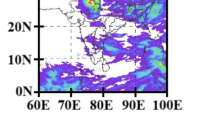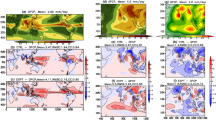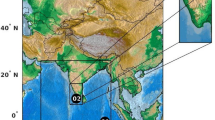Abstract
This study evaluates the performances of four different cloud microphysical parameterization (CMP) schemes of the Weather Research and Forecasting (WRF) model at 3 km horizontal resolution (lead time up to 96 h) for the Heavy Rainfall Event (HRE) over Kerala in August 2018. The goal is to identify the major drivers for rain making mechanism and evaluate the ability of CMPs to accurately simulate the event with special emphasis on rainfall. It is found that the choice of CMP has a considerable impact on the rainfall forecast characteristics and associated convection. Results are validated against the India Meteorological Department (IMD) station data and Global Precipitation Measurement (GPM) observations and found that, among the four CMP schemes, viz., Milbrandt (MIL), Thompson Aerosol Aware (TAA), WRF double-moment 6-class scheme (WDM6) and WRF single-moment 6-class scheme (WSM6); WDM6 is the best performing scheme in terms of rainfall. It is noted that mixed phase processes are dominant in this scenario and the inability (ability) of MIL and TAA (WDM6 and WSM6) to predict the frozen hydrometeors, and thus simulating the cold rain processes realistically led to large (small) errors in the rainfall forecast. The moisture convergence was prominent in the foothills of the Western Ghats and highly influential in facilitating orography driven lifting of moisture. The moisture budget results suggest that horizontal moisture flux convergence (MFC) was the major driver of convection with WDM6 predicting the peaks of MFC most consistently with the observed Tropical Rainfall Measuring Mission (TRMM) rainfall product. Additionally, from Contiguous Rain Area analysis it is also found that the WDM6 has the least volumetric error. This is to highlight that hydrometeor distributions are strongly modulated by MFC, which further impacts the latent heat generation and rainfall over the region. Overall results infer the substantial influence of CMPs on the forecast of the Heavy Rainfall Event. The findings of this study will be highly useful for operational forecasting agencies and disaster management authorities for mitigation of damages caused by this kind of severe HREs in the future.


Source: Daily Weather Report, IMD Thiruvananthapuram. https://www.imdtvm.gov.in/index.php?option=com_content&task=view&id=21&Itemid=35
















Similar content being viewed by others
Abbreviations
- WRF:
-
Weather research and forecasting
- HRE:
-
Heavy rainfall event
- CMP:
-
Cloud microphysical parameterization
- IMD:
-
India Meteorological Department
- GPM:
-
Global precipitation mission
- MIL:
-
Milbrandt scheme
- TAA:
-
Thompson aerosol aware scheme
- WDM6:
-
WRF Double Moment 6-class Scheme
- WSM6:
-
WRF Single Moment 6-class Scheme
- MFC:
-
Moisture flux convergence
- TRMM:
-
Tropical rainfall measuring mission
- HRLDAS:
-
High resolution land data assimilation
- NWP:
-
Numerical weather prediction
- DTC-UPP:
-
Development testbed center unified post processor
- WRF-ARW:
-
Advanced research WRF
- NOAA:
-
National Oceanic and Atmospheric Administration
- NCEP:
-
National Center for Environmental Prediction
- FSL:
-
Forecast System Laboratory
- GDAS:
-
Global data assimilation system
- NASA:
-
National Aeronautics and Space Administration
- JAXA:
-
Japan Aerospace Exploration Agency
- CC:
-
Correlation coefficient
- RMSE:
-
Root mean square error
- 3AR:
-
3 Day accumulated rainfall from 13 to 15th August
- ETS:
-
Equitable Threat Score
- HSS:
-
Heidke Skill Score
- CRA:
-
Contiguous rainfall area
- MSE:
-
Mean squared error
- ECMWF:
-
European Centre for Medium Range Weather Forecast
- ERA5:
-
ECMWF reanalysis 5th generation
- DWR:
-
Doppler weather RADAR
- CFAD:
-
Contour frequency altitude diagram
- w.r.t.:
-
With respect to
- UGC:
-
University Grants Commission
- SERB:
-
Science and Engineering Research Board
References
Agnihotri G, Dimri AP (2015) Simulation study of heavy rainfall episodes over the southern Indian peninsula. Meteorol Appl 22:223–235. https://doi.org/10.1002/met.1446
Ahern M, Kovats RS, Wilkinson P, Few R, Matthies F (2005) Global health impacts of floods: epidemiologic evidence. Epidemiol Rev 27:36–46. https://doi.org/10.1093/epirev/mxi004
Ault AP, Williams CR, White AB, Neiman PJ, Creamean JM, Gaston CJ, Ralph FM, Prather KA (2011) Detection of Asian dust in California orographic precipitation. J Geophys Res 116:D16205. https://doi.org/10.1029/2010JD015351
Baisya H, Pattnaik S (2019) Orographic effect and multiscale interactions during an extreme rainfall event. Environ Res Commun 1:051002. https://doi.org/10.1088/2515-7620/ab2417
Banacos PC, Schultz DM, Banacos PC, Schultz DM (2005) The use of moisture flux convergence in forecasting convective initiation: historical and operational perspectives. Weather Forecast 20:351–366. https://doi.org/10.1175/WAF858.1
Breiland JG (1958) Meteorological conditions associated with the develpoment of instability lines. J Meteorol 15:297–302. https://doi.org/10.1175/1520-0469(1958)015%3c0297:MCAWTD%3e2.0.CO;2
Chen Y, Ebert EE, Davidson NE, Walsh KJE (2018) Application of contiguous rain area (CRA) methods to tropical cyclone rainfall forecast verification. Earth Space Sci. https://doi.org/10.1029/2018EA000412
Dasari HP, Salgado R, Perdigao J, Challa VS (2014) A regional climate simulation study using WRF-ARW model over Europe and evaluation for extreme temperature weather events. Int J Atmos Sci 2014:1–22. https://doi.org/10.1155/2014/704079
Dodla VBR, Ratna SB (2010) Mesoscale characteristics and prediction of an unusual extreme heavy precipitation event over India using a high resolution mesoscale model. Atmos Res 95:255–269. https://doi.org/10.1016/j.atmosres.2009.10.004
Dudhia J (1989) Numerical study of convection observed during the winter monsoon experiment using a mesoscale two-dimensional model. J Atmos Sci 46:3077–3107. https://doi.org/10.1175/1520-0469(1989)046%3c3077:NSOCOD%3e2.0.CO;2
Ebert E, Gallus W (2009) Toward better understanding of the contiguous rain area (CRA) method for spatial forecast verification. Weather Forecast 24(5):1401–1415
Ebert E, McBride J (2000) Verification of precipitation in weather systems: determination of systematic errors. J Hydrol 239:179–202. https://doi.org/10.1016/S0022-1694(00)00343-7
Ghosh P, Ramkumar TK, Yesubabu V, Naidu CV (2016) Convection-generated high-frequency gravity waves as observed by MST radar and simulated by WRF model over the Indian tropical station of Gadanki. Q J R Meteorol Soc 142:3036–3049. https://doi.org/10.1002/qj.2887
Grams J, Gallus W, Koch S (2006) The use of a modified Ebert-McBride technique to evaluate mesoscale model QPF as a function of convective system morphology during IHOP 2002. Weather Forecast 21:288
Grubisic V, Vellore RK, Huggins AW (2005) Quantitative precipitation forecasting wintertime storms in the Sierra Nevada: sensitivity to the microphysical parameterization. Mon Weather Rev 133:2834–2859
Hally A, Richard E, Fresnay S, Lambert D (2014) Ensemble simulations with perturbed physical parametrizations: pre-HyMeX case studies. Q J R Meteorol Soc 140:1900–1916. https://doi.org/10.1002/qj.2257
Hersbach H, Bell B, Berrisford P, Biavati G, Horányi A, Muñoz Sabater J, Nicolas J, Peubey C, Radu R, Rozum I, Schepers D, Simmons A, Soci C, Dee D, Thépaut J-N (2018) ERA5 hourly data on pressure levels from 1979 to present. Copernicus Climate Change Service (C3S) Climate Data Store (CDS). https://doi.org/10.24381/cds.bd0915c6
Hong SY, Pan HL, Hong SY, Pan HL (1996) Nonlocal boundary layer vertical diffusion in a medium-range forecast model. Mon Weather Rev 124:2322–2339. https://doi.org/10.1175/1520-0493(1996)124%3c2322:NBLVDI%3e2.0.CO;2
Hong SY, Lim KSS, Lee YH, Ha JC, Kim HW, Ham SJ, Dudhia J (2010) Evaluation of the WRF double-moment 6-class microphysics scheme for precipitating convection. Adv Meteorol 2010:1–10. https://doi.org/10.1155/2010/707253
Huang YC, Wang PK (2017) The hydrometeor partitioning and microphysical processes over the Pacific Warm Pool in numerical modeling. Atmos Res. https://doi.org/10.1016/j.atmosres.2016.09.009
Huffman GJ et al (2007) The TRMM multi-satellite precipitation analysis (TMPA): quasi global, multiyear, combined-sensor precipitation estimates at fine scales. J Hydrometeorol 8(1):38–55
Huffman GJ, Bolvin D, Braithwaite D, Hsu K, Joyce R, Xie P (2014) Integrated multi-satellite retrievals for GPM (IMERG), version 4.4. NASA's Precipitation Processing Center, ftp://arthurhou.pps.eosdis.nasa.gov/gpmdata/. Accessed 10 Dec 2020
IMD Report (2018) Rainfall over Kerala during Monsoon Season-2018 and forecast for next 5 days. www.imdtvm.gov.in/images/rainfall%20over%20kerala%20during%20monsoon%20season-2018%20and%20forecast%20for%20next%205%20days.pdf
John SK (2004) The Kain-Fritsch convective parameterization: an update. J Appl Meteorol 43:170–181. https://doi.org/10.1175/1520-0450(2004)043<0170:TKCPAU>2.0.CO;2
Kaplan M, Vellore RK, Marzette PJ, Lewis JM (2012) The role of windward side diabatic heating in Sierra Nevada spillover precipitation. J Hydromet 13:1175–1194
Kumar O, Suneetha P (2012) Simulation of heavy rainfall events during retreat phase of summer monsoon season over parts of Andhra Pradesh. file.scirp.org. http://file.scirp.org/pdf/IJG20120400020_70895938.pdf
Lim J-OJ, Hong S-Y (2005) Effects of Bulk Microphysics on the Simulated Monsoonal Precipitation over East Asia. J Geophys Res 110:D24201. https://doi.org/10.1029/2005JD006166
Lim KSS, Hong SY (2009) Development of an effective double-moment cloud microphysics scheme with prognostic cloud condensation nuclei (CCN) for weather and climate models. Mon Weather Rev 138:1587–1612. https://doi.org/10.1175/2009mwr2968.1
Matsumoto S, Ninomiya K, Akiyama T (1967) Cumulus activities in relation field to the mesoscale convergence. J Met Soc Jpn 45:292–305
McCumber M, Tao WK, Simpson J, Penc R, Soong ST (2010) Comparison of ice-phase microphysical parameterization schemes using numerical simulations of tropical convection. J Appl Meteorol. https://doi.org/10.1175/1520-0450-30.7.985
Milbrandt JA, Yau MK (2005) A Multimoment bulk microphysics parameterization. Part I: analysis of the role of the spectral shape parameter. J Atmos Sci 62:3051–3064. https://doi.org/10.1175/JAS3534.1
Mlawer EJ, Taubman SJ, Brown PD, Iacono MJ, Clough SA (1997) Radiative transfer for inhomogeneous atmospheres: RRTM, a validated correlated-k model for the longwave. J Geophys Res Atmos 102:16663–16682. https://doi.org/10.1029/97JD00237
Monin AS, Obukhov AM (1954) Basic laws of turbulent mixing in the atmosphere near the ground. Tr Akad Nauk SSSR Geofiz Inst 24:163–187
Morrison H, Curry JA, Khvorostyanov VI, Morrison H, Curry JA, Khvorostyanov VI (2005) A new double-moment microphysics parameterization for application in cloud and climate models. Part I: description. J Atmos Sci 62:1665–1677. https://doi.org/10.1175/JAS3446.1
NCEP: National Centers for Environmental Prediction/National Weather Service/NOAA/U.S. Department of Commerce (2015) NCEP GDAS/FNL 0.25 degree global tropospheric analyses and forecast grids. Research Data Archive at the National Center for Atmospheric Research, Computational and Information Systems Laboratory. https://doi.org/10.5065/D65Q4T4Z
Niu GY, Yang ZL, Mitchell KE, Chen F, Ek MB, Barlage M, Kumar A, Manning K, Niyogi D, Rosero E, Tewari M, Xia Y (2011) The community Noah land surface model with multiparameterization options (Noah-MP). 1: Model description and evaluation with local-scale measurements. J Geophys Res 116:D12109. https://doi.org/10.1029/2010JD015139
Pattanaik DR, Rajeevan M (2009) Variability of extreme rainfall events over India during southwest monsoon season. Meteorol Appl. https://doi.org/10.1002/met.164
Peslen CA (1980) Short-interval SMS wind vector determinations for a severe local storms area. Mon Weather Rev 108:1407–1418. https://doi.org/10.1175/1520-0493(1980)108%3c1407:SISWVD%3e2.0.CO;2
Powers JG, Klemp JB, Skamarock WC, Davis CA, Dudhia J, Gill DO, Coen JL, Gochis DJ, Ahmadov R, Peckham SE, Grell GA, Michalakes J, Trahan S, Benjamin SG, Alexander CR, Dimego GJ, Wang W, Schwartz CS, Romine GS, Liu Z, Snyder C, Chen F, Barlage MJ, Yu W, Duda MG (2017) The weather research and forecasting model: overview, system efforts, and future directions. Bull Am Meteorol Soc 98:1717–1737. https://doi.org/10.1175/BAMS-D-15-00308.1
Rajeevan M, Kesarkar A, Thampi SB, Rao TN, Radhakrishna B, Rajasekhar M (2010) Sensitivity of WRF cloud microphysics to simulations of a severe thunderstorm event over Southeast India. Ann Geophys 28:603–619. https://doi.org/10.5194/angeo-28-603-2010
Rajesh PV, Pattnaik S, Rai D, Osuri KK, Mohanty UC, Tripathy S (2017) Role of land state in a high resolution mesoscale model for simulating the Uttarakhand heavy rainfall event over India. J Earth Syst Sci 125:475–498
Reshmi Mohan P, Srinivas CV, Yesubabu V, Baskaran R, Venkatraman B (2018) Simulation of a heavy rainfall event over Chennai in Southeast India using WRF: sensitivity to microphysics parameterization. Atmos Res 210:83–99. https://doi.org/10.1016/j.atmosres.2018.04.005
Saha K (1974) Some aspects of the Arabian sea summer monsoon. Tellus 26:464–476. https://doi.org/10.1111/j.2153-3490.1974.tb01624.x
Skamarock C, Klemp B, Dudhia J, Gill O, Barker D, Duda G, Huang X, Wang W, Powers G (2008) A description of the advanced research WRF version 3. https://doi.org/10.5065/D68S4MVH
Srinivas CV, Yesubabu V, Prasad DH, Hari Prasad KBRR, Greeshma MM, Baskaran R, Venkatraman B (2018) Simulation of an extreme heavy rainfall event over Chennai, India using WRF: sensitivity to grid resolution and boundary layer physics. Atmos Res 210:66–82. https://doi.org/10.1016/J.ATMOSRES.2018.04.014
Tan E (2016) Microphysics parameterization sensitivity of the WRF model version 3.1.7 to extreme precipitation: evaluation of the 1997 New Year’s flood of California. Geosci Model Dev Discuss. https://doi.org/10.5194/gmd-2016-94
Taylor KE (2001) Summarizing multiple aspects of model performance in a single diagram. J Geophys Res Atmos 106:7183–7192. https://doi.org/10.1029/2000JD900719
Thompson G, Eidhammer T (2014) A study of aerosol impacts on clouds and precipitation development in a large winter cyclone. J Atmos Sci 71:3636–3658. https://doi.org/10.1175/jas-d-13-0305.1
Thompson G, Field PR, Rasmussen RM, Hall WD (2008) Explicit forecasts of winter precipitation using an improved bulk microphysics scheme. Part II: implementation of a new snow parameterization. Mon Weather Rev 136:5095–5115. https://doi.org/10.1175/2008MWR2387.1
Vellore RK et al (2014) On the anomalous precipitation enhancement over the Himalayan foothills during monsoon breaks. Clim Dyn 43:2009–2031
Vellore RK et al (2019) Sub-synoptic variability in the Himalayan extreme precipitation event during June 2013. Meteorol Atmos Phys. https://doi.org/10.1007/s00703-019-00713-5
Vellore RK, Kaplan ML, Krishnan R, Lewis JM, Sabade S, Deshpande N, Singh BB, Madhura RK, Rama Rao MVS (2016) Monsoon-extratropical circulation interactions in Himalayan extreme rainfall. Clim Dyn 46:3517–3546. https://doi.org/10.1007/s00382-015-2784-x
Viswanadhapalli Y, Srinivas CV, Basha G, Dasari HP, Langodan S, Ratnam MV, Hoteit I (2019) A diaghnostic study of extreme precipitation over Kerala during August 2018. Atmos Sci Let 20:e941. https://doi.org/10.1002/asl.941
Wilks DS (ed) (2011) Statistical methods in the atmospheric sciences. International Geophysics, vol 100, pp 2–676
Wilson JW, Megenhardt DL (1997) Thunderstorm initiation, organization, and lifetime associated with florida boundary layer convergence lines. Mon Weather Rev 125:1507–1525. https://doi.org/10.1175/1520-0493(1997)125%3C1507:TIOALA%3E2.0.CO;2
Wilson JW, Mueller CK (1993) Nowcasts of thunderstorm initiation and evolution. Weather Forecast 8:113–131. https://doi.org/10.1175/1520-0434(1993)008%3c0113:NOTIAE%3e2.0.CO;2
Wilson JW, Schreiber WE (1986) Initiation of convective storms at radar-observed boundary-layer convergence lines. Mon Weather Rev 114:2516–2536. https://doi.org/10.1175/1520-0493(1986)114%3c2516:IOCSAR%3e2.0.CO;2
Yuter SE, Houze RA (1995) Three-dimensional kinematic and microphysical evolution of Florida Cumulonimbus. Part II: frequency distributions of vertical velocity, reflectivity, and differential reflectivity. Mon Weather Rev 123:1941–1963. https://doi.org/10.1175/1520-0493(1995)123%3c1941:TDKAME%3e2.0.CO;2
Zhang M, Wang H, Zhang X, Peng Y, Che H (2018) Applying the WRF double-moment six-class microphysics scheme in the GRAPES_Meso Model: a case study. J Meteorol Res 32:246–264. https://doi.org/10.1007/s13351-018-7066-1
Acknowledgements
The authors are grateful to the Indian Institute of Technology Bhubaneswar for providing the infrastructure to carry out this research work. The authors acknowledge the funding support from the University Grants Commission (UGC) (Grant number A18ES09002) and the Science and Engineering Research Board (SERB) (Grant number RP-193), Government of India. The authors also acknowledge NCEP for the FNL/GDAS data used as the initial and boundary condition for the simulations. The authors are also grateful to the National Aeronautics and Space Administration (NASA) Earth Data for providing the GPM Final Run observations and TRMM 3B42 3-hourly rainfall data. The figures have been created using MATLAB (www.mathworks.com), and the algorithms are available upon request to the corresponding author.
Author information
Authors and Affiliations
Corresponding author
Additional information
Responsible Editor: C. Simmer.
Publisher's Note
Springer Nature remains neutral with regard to jurisdictional claims in published maps and institutional affiliations.
Rights and permissions
About this article
Cite this article
Chakraborty, T., Pattnaik, S., Jenamani, R.K. et al. Evaluating the performances of cloud microphysical parameterizations in WRF for the heavy rainfall event of Kerala (2018). Meteorol Atmos Phys 133, 707–737 (2021). https://doi.org/10.1007/s00703-021-00776-3
Received:
Accepted:
Published:
Issue Date:
DOI: https://doi.org/10.1007/s00703-021-00776-3




